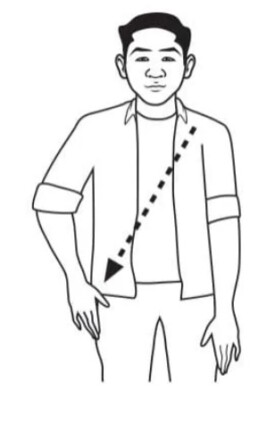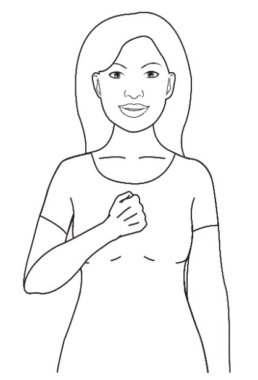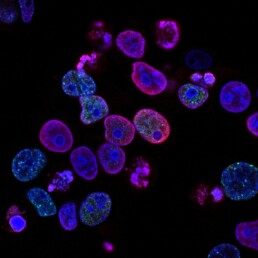War, Disaster, Poverty: energy psychology delivers results
There is a shortage of mental health resources in many parts of the world, yet people in these areas need access to quality interventions, especially after experiencing natural or human-made disasters. Suzanne Connolly and her team delved into the research to see what interventions work best in these situations, and published a meta-analysis in the Bulletin of the World Health Organization. Among the interventions studied, energy psychology delivered results! TFT performed well, receiving medium to high effect sizes in a shorter time with faster training than other interventions.
Study methods
All studies included in the analysis were delivered by laypeople that were trained by professionals. The studies measured a variety of mental health concerns and were published between 2000 and 2019. Of the 19 studies identified, 10 were conducted in Africa and nine in Asia. The studies covered a variety of conditions: 13 studied PTSD, three studied depression, two studied alcohol dependence, and one studied mixed depression and anxiety.
The techniques used included CBT (six studies); behavior therapy with psychoeducation (six studies); TFT (three studies); narrative exposure therapy (two studies); and interpersonal psychotherapy (two studies).
The time it took to train the lay counselors varied widely, with the shortest training taking just two days (TFT) and the longest taking one year (classroom-based CBT). Treatment duration varied widely as well. The shortest duration of treatment was in the TFT studies, which lasted one day; the longest was the classroom-based CBT, which included 15 sessions.
Study conclusions: energy psychology delivered results!
Overall, therapies delivered by professionally trained lay counselors had a medium effect size, suggesting that this is indeed a practical way to bring mental health treatment to areas in need.
Fourteen of the 20 studies trials found statistically significant effects; six found no effect. The TFT studies fared well: two had large effect sizes and one had a medium effect size. Indeed, energy psychology delivered results better than other therapies.
Why this study matters
There is a shortage of mental health workers in the world, particularly in low- and middle-income countries. The problem comes into stark relief in the aftermath of natural or human-made disasters. The World Health Organization (WHO) has recommended enlisting community members to bridge this gap. This study shows that professionally trained members of the community can indeed provide effective mental health interventions.
A win for energy psychology
While the goal of the study was to examine the effectiveness of therapies delivered by professionally trained lay counselors, the data also show that TFT produces impressive results with the shortest amount of training and treatment time: just one day of treatment delivered after just two days of training.
This positions TFT well as a relatively easy to learn and implement, effective strategy to address mental health issues in lower- and middle-income countries where there is a lack of robust mental health infrastructure.
For more information
If you would like to learn TFT, you can take ACEP's online course, taught by Suzanne Connolly herself, while earning 13 CE credits. Find out more at energypsych.org.
Sarah Murphy is a Licensed Professional Counselor with 15 years of clinical experience. She serves as Communications Committee Chair for ACEP. In addition to her private practice, she is Staff Therapist for Unite for HER. She specializes in energy psychology, including EFT, as well as mindfulness and hypnotherapy. Send comments to SarahMurphyLPC@gmail.com.
Feeling clumsy? Try this.
Read on to learn an easy tool you can use to boost your coordination.
When you find yourself bumping into things and losing your coordination, it's a pretty good sign that your energy field is out of balance. You can get yourself back in balance by practicing the Crossover should pull or the standing version, the Cross Crawl. Both of these simple body-based techniques help restore left-right balance and allow you to feel more clear and connected. The crossover shoulder pull was adapted by Phil Mollon from Roger Callahan's Thought Field Therapy. Practice the technique right now by watching the video below and following along. You can also download written instructions in English, Spanish, and Portuguese.
How it Works
You can also do the Crossover Shoulder Pull, drawing your hand from the opposite shoulder to the same-side hip: right hand on left shoulder, down to right hip; left hand on right shoulder, down to left hip.
Why It Works
The Cross Crawl balances our energy field. We move our energy when we move our bodies. Doing this with crossing over activates both sides of our brains, which is always grounding.
This technique is also excellent to use when you need to focus or if you feel scrambled. It helps you feel "together."
If you haven’t given the Brain Balancer technique a try yet, do it now. Take notice of how your body feels both before and after you use the technique. This technique is just one of many you can use to get more calm and present.
More Techniques to help when you feel clumsy
If you found the Brain Balancer helpful, here are a few more tools you can use to calm down and get present: Breathing Into Balance and the Cross Crawl.
All of the videos and techniques in our "Try This" series were created by ACEP's Humanitarian Committee in order to help people heal by spreading the word about the powerful effects of energy psychology techniques. We invite you to help by sharing this information!
If you want to learn to use tools like this to improve your wellbeing, contact me.
Video Resources Provided by the ACEP Humanitarian Committee
The mission of the ACEP Humanitarian Committee is to develop and implement humanitarian projects that alleviate emotional distress caused by catastrophic natural and man-made events around the globe. We do this by encouraging and assisting ACEP members in developing humanitarian projects that utilize recognized energy psychology and other modalities that meet ACEP’s standards and guidelines. Learn more here.
Research on Integrative Therapies and Cancer Survivorship
Research shows that cancer patients in hospitals that incorporate integrative therapies have a much better survival rate than those whose hospitals do not incorporate these tools. A study by Terri Crudup and her colleagues was published by the online Journal of Oncology in January of 2022. The study examined the relationship between treating hospital's use of integrative therapies and cancer survivorship. While other studies have looked at the subjective wellbeing of patients using some of these therapies, this study is the first to look at institutional endorsement of integrative therapies and patient survivorship.
Moreover, more is better. In this study, patients in hospitals that incorporated just a "low-mid level" of integrative therapies had triple the 5-year survivorship of those treated at institutions that did not use integrative therapies. Significantly, patients treated in hospitals with "high levels" of integrative therapies had a 48% increase in 5-year survivorship.
The theory
A cancer diagnosis impacts the whole person, affecting not just physical wellbeing. It also creates a cascade of emotional and mental health correlates. Additionally, it often prompts a spiritual crisis. It makes sense, then, that integrative therapies are popular among cancer patients. Integrative therapy is the term used for the combination of complementary and lifestyle therapies with conventional medical treatment.
Some of the most popular integrative approaches include nutrition counseling, exercise counseling, massage therapy and support groups. Others include meditation, biofield therapies, and physical practices like yoga and chi gong. However, without institutional involvement, these therapies are difficult for patients to find and to afford. Patient demand alone might not be enough to enroll other hospitals into the integrative world – but research like this might.
The study setup
Participants: The study included 172 patients, treated by 103 oncologists from 103 institutions. All patients were adult women. They had been treated for breast cancer in 2013 and 2014. Among the women in the study, the median age was 51. Finally, eight percent of participants had metastatic disease.
Scoring system for institutional involvement in integrative therapies: The researchers identified 12 therapies that are popular among breast cancer patients, listed below. Then they questioned providers about their institutional involvement on three metrics:
- First, educate: increase patient knowledge of integrative therapy
- Secondly, support: recommend, provide access to integrative therapy
- Thirdly, provide: institution covers partial or full cost of integrative therapy
Integrative therapies included in the study
- Nutrition consultation or program
- Exercise consultation or program
- Patient support groups or patient-survivor pairing
- Spiritual services
- Psycho-oncology support
- Massage therapy
- Meditation or mindfulness
- Yoga
- Acupuncture or acupressure
- Music or art therapy
- Reiki, Healing Touch, Therapeutic Touch
- Tai chi or chi gong
- Study results
Study results
As noted in the beginning of this article, patients in hospitals that had just a low- to mid-level use of integrative therapies had triple the 5-year survivorship of those treated at institutions that had low involvement of integrative therapies. This was based on multivariate analysis (see below). Here is the breakdown:
5-year survivorship by level of institutional involvement
- low cohort: 89%
- low-mid cohort: 96%
- mid-high cohort: 96%, and
- high cohort: 95%
Considering other factors (multivariate modeling)
Increased odds of 5-year survivorship include:
- An older age at diagnosis (66–76),
- Having a PPO insurance plan,
- Being treated in an academic setting, and
- Being treated by an institution with a low-mid or mid-high integrative involvement score.
Of note
You may have noticed that the increase in survivorship among patients of hospitals with "low-to mid-level" involvement with integrative therapies was quite high. In contrast, however, the incremental benefit for patients treated at institutions with high-level involvement was relatively low. The authors not that this might be due to increased illness among people seeking treatment centers that offer these services.
Integrative therapies are different to alternative therapies. Integrative therapies are incorporated along with conventional treatments. Alternative therapies, however, are just that - an alternative to conventional treatment. And not surprisingly, they don't get good results. In fact, a 2018 study published in the Journal of the National Cancer Institute had found that people who used alternative therapies had worse outcomes than those who followed conventional medical practices.
Integrative therapies and cancer survivorship: a positive impact.
This study adds to the growing body of evidence supporting the use of integrative therapies. Indeed, these therapies offer a sense of safety and increase wellbeing among patients. However, they are more than feel-good therapies. The results of this study suggest that in fact, they impact survivorship.
The people of Energy Psychology: Asha Clinton
The People of EP: Meet Asha Clinton, founder of Advanced Integrative Therapy
Advanced Integrative Therapy, or AIT, is gaining popularity in the field of energy psychology. AIT is helping people heal from trauma in the United States and around the world. Asha Clinton, PhD., is the person who brought AIT to the world. However, she does not take credit for creating it. Rather, she says that she received AIT. No matter how it started, Asha has shared this gift with hundreds of practitioners and thousands of clients. Her AIT story is here:
Meet our hero: Asha Clinton
Asha spent her career as a psychotherapist in Princeton, New Jersey, where she and her late husband were faculty members at the famed university. As a new mom, psychotherapist in full-time practice, humanitarian aid worker and wife, her calendar was quite full. She says that when her daughter was young, Asha’s only quiet time was on Sundays in the tub.
It was during one of these baths that the structure and first protocol for AIT came to her. During a nap, Asha learned exactly how to execute this powerful healing protocol. Excited, and not wanting to lose what she had received, Asha jumped out of the tub and ran to her computer. Thus, AIT came to be.
Conventional talk therapy has its place, but often therapists seek different tools to help clients heal faster. Asha had an interest Eastern thought and had investigated other energy psychology modalities. She was always looking for ways to help her clients heal from the wounds of the past and create lives they can be excited about. Within that framework, Asha was primed to receive the gift of AIT.
What’s different about AIT
AIT is a chakra- and language-based energy psychology method. Since its inception in the late 1990s, the technique has helped thousands of people overcome many human difficulties, from dealing with illness to the aftermath of trauma.
The goal of AIT is to treat as many underlying causes of suffering as possible, so that healing can happen. Because of this, it is a trauma-focused approach. It focuses directly on any experience that triggers difficult feelings, elicits negative thoughts, and blocks us from our spiritual development. AIT is holistic in that it works with our physical, mental/emotional, and spiritual nature.
Humanitarian work:
Asha and her team have dedicated time and effort to humanitarian work, bringing AIT to communities that have experienced human-made or natural disasters. This work includes working a group of Mayan women in Guatemala who had been profoundly wounded in the recent Guatemalan Civil War. These women had endured horrific trauma, such as watching their entire families murdered in front of their eyes. The women suffered yet persevered, seeking to restore both hope and meaning to their lives. Asha shared AIT with these women, helping them to heal and move forward.
Today, the AIT practice continues in Guatemala, this time helping people recover from the trauma of the eruption of Volcán de Fuego Chi gag in 2018. Bringing treatment to those in need, a dedicated team of AIT practitioners visited the affected communities weekly until their help was no longer needed.
Looking forward:
Two studies are underway in the US investigating the usefulness of AIT in the treatment of cancer. Other case studies, such as one involving intergenerational trauma, point to the variety of conditions AIT can address. These studies will add to the growing research base exploring and explaining energy psychology.
If you would like to learn more about Asha and AIT, you can see her at the 2022 ACEP conference, where she is an invited presenter.
Distressed? Try tapping.
A study from Colombia shows it works
In late 2021, the World Journal of Biology Pharmacy and Health Sciences published a study by Fernando Vicente Barraza-Alvarez from the University of Cordoba in Colombia. It examined psychological measures of 14 women working in a childcare center in Texcoco, Mexico. Without a doubt, the study found that Thought Field Therapy (TFT) reduced subjective distress (SUDs) from a high of eight, nine or ten on a ten-point scale, all the way to zero – Z E R O. Callahan’s thought field therapy in the management of emotions associated with stress is a small study. But, with its graphics and clear procedural explanations, it provides a compelling story of how quickly and efficiently TFT can help people who are distressed feel better.
The theory: how tapping could help people who are distressed
The study took place at Universidad Autónoma Chapingo in Texcoco, Mexico. As a matter of fact, this university is internationally renowned for its defense of, and research into, complementary and alternative medical (CAM) therapies. These modalities, including TFT, fill an important need for cultural openness and sensitivity as well as patient/client choice. TFT is appealing because it is rapid, noninvasive, economical, easy to learn, and can be used both therapeutically and as a self-help tool. With this in mind, researchers wondered if TFT could help distressed women address a variety of mental health issues.
The study setup
Fourteen women participated in the study. They were childcare workers at a nearby center, aged 19 to 47. They were distressed because of anxiety, fear, obsession, or rejection. The data were self-report, using a 10-point scale. This was a simple pre-post study, with measures taken before and after treatment with TFT. The women also wrote about their experiences, adding qualitative data to the results.
For treatment, they used specific tapping sequences for their various complaints, as well as the 9-gamut and “brain gymnastics” (brain gymnastics is tapping accompanied by slow, vertical eye movement) sequences.
The tapping sequences were as follows:
- obsession: collar bone, under eye, collar bone (3 women)
- fear: under arm, under eye, collar bone (4 women)
- anxiety: under eye, under arm, collar bone (5 women)
- rejection: eyebrow, under eye, under arm, collar bone (2 women)
Study results
Quantitative data:
All the women experienced complete relief from their distress. In other words, their scores went down to a zero out of ten using the self-rating SUD scale.
Researchers also questioned the women about three features of TFT: Was it rapid? Was it effective? Was it believable? In every case, the variables were near the maximum score of five (out of five) for all features, using the Likert-type scale created for these measures.
Qualitative data:
Some of the comments the women wrote regarding their TFT experience:
- “I felt relaxed and in a better state of health.” (Fear)
- “Now I have a lot of courage.” (Obsession)
- “I feel like a weight has been lifted off my shoulders.” (Anxiety)
- “I no longer care about some people’s criticisms and attacks towards me. This was so sudden, and I already feel free.” (Rejection)
Cultural sensitivity
Barraza-Alvarez notes that medical systems are “enriched by the ethnic and cultural diversity of communities.” Complementary approaches work to balance the mind, body, and soul. But mainstream Western practitioners often reject these approaches. Today, increasing cultural sensitivity and sharing information lead people increasingly to seek CAM approaches. These approaches work well alongside mainstream methods. Indeed, the two models – Western and CAM – can be complementary, rather than antagonistic.
Why this study matters
The present study builds on the research base supporting TFT, the “father” of all of today’s tapping techniques. Roger Callahan, with TFT, was the first to use acupoint tapping in Western psychological treatment. We all can share a moment of gratitude to him, and to all those who have worked to further the field through research and practice. When we use techniques like this, in short, we are healing the world.
Want to learn more about TFT? Check out ACEP’s TFT training course, taught by Suzanne Connolly. If you are distressed and want to explore tapping to reduce your distress, contact me.
Feeling groggy? Try this.
If you’re feeling groggy and want to learn how to revive, you’re in the right place. This blog teaches you an easy tool you can use right now to help you wake up.
One of the fastest and most effective ways to become awake and alert when you're feeling groggy is to use the Thymus Thump. This is a simple body-based technique that helps you increase your life-force energy. It was developed by Energy Psychology pioneer John Diamond. Practice the technique right now by watching the video below and following along. You can also download written instructions in English, Spanish, and Portuguese.
How it Works
Simply tap on the middle of your chest, using a closed fist. It's even better when you plaster a smile on your face while doing it. Give it a try! Then notice how your body feels both before and after you use the technique. This technique is just one of many you can use to increase the flow of energy and feel more awake and alert.
Why It Works
By using energy psychology techniques like the Thymus Thump, you are interacting with your body's energy system. When you use the Thymus Thump, you are increasing the flow of energy through your system. This allows you to feel awake and alert, quickly and easily. The technique is also helpful if you feel anxious or panicky, and will help you after a shock or trauma.
More Techniques to help when you are feeling groggy
If you found the Thymus Thump helpful, here are a few more tools you can use to increase your energy: Four Thumps and Heel Shock Release. ACEP's Humanitarian Committee created all the videos in the "try this" series to help people heal by spreading the word about the powerful effects of energy psychology techniques. I invite you to help by sharing this information!
If you want to learn to use tools like this to help manage your feelings, contact me.
Video Resources Provided by the ACEP Humanitarian Committee
The mission of the ACEP Humanitarian Committee is to develop and implement humanitarian projects that alleviate emotional distress caused by catastrophic natural and man-made events around the globe. We do this by encouraging and assisting ACEP members in developing humanitarian projects that utilize recognized energy psychology and other modalities that meet ACEP’s standards and guidelines. Learn more here.
Healing sexual abuse with EP tools
Research shows Energy Psychology tools are effective in healing sexual trauma
By John Freedom and Sarah Murphy
Sexual violence is one of the greatest traumas a human can experience. It affects millions of Americans, leaving lasting effects on functioning and wellbeing. It is notoriously difficult to address using conventional talk therapy. Moreover, the research on conventional talk therapy, including cognitive behavioral therapy (CBT), for sexual violence is poor, with high dropout rates and only modest gains. Clearly, we need tools for healing sexual abuse. Research shows that energy psychology tools such as EFT may fit the bill.
Background
Sexual violence affects more than one third of women worldwide, according to the World Health Organization. Men can also experience sexual violence; the rates are difficult to determine due to underreporting, according to the United Nations. More than one half the time, people are sexually assaulted by someone they know. Moreover, there is such a stigma of guilt and shame, where many victims blame themselves for what happened.
Energetic and somatic therapies are particularly effective at addressing trauma. Therefore, it stands to reason that they would be effective in addressing the trauma of sexual violence. EP has demonstrated efficacy with traumatized populations. Recently, Feinstein (2021) found that almost all – 77 of 79 – studies that included long-term follow-up found participant gains held over time, demonstrating how powerful and effective these techniques can be.
Research overview: Studies show EP helpful in healing sexual abuse
Clearly, we need for effective therapeutic tools to help people who have experienced sexual abuse. Thankfully, there is hope: EP techniques might fill that need. Clinicians who are interested in incorporating EP in their work with survivors of childhood sexual abuse may find this article particularly relevant. Our hope is that the results can provide guidelines for therapists considering incorporating these techniques into their practices. This article explores what the research tells us so far:
Adult survivors of childhood sexual abuse:
The first study we will explore was done by Kirsten Schulz (2009). She evaluated the experiences of 12 therapists (with a minimum of ten years’ experience) who had integrated EP into their treatments for adult survivors of childhood sexual abuse. In this qualitative study, the researcher explored the therapists’ experiences with their clients. The therapists reported that using EP with their clients who had experienced childhood sexual abuse was helpful because:
- EP does not require clients to talk about their trauma,
- EP reliably reduces trauma without having the client re-experience distress,
- After EP therapy, clients can discuss core issues without discomfort,
- EP techniques are the most effective treatment for anxiety disorders, and
- Finally, the rapid rate of healing can affect treatment goals.
Sexual assault-specific PTSD:
For our second study we will discuss the findings of Anderson, Rubik and Absenger (2019). They explored the effectiveness of combining EFT and Hypnosis in the treatment of sexual assault-specific post-traumatic stress disorder symptoms. This study was conducted in a private psychotherapy office and utilized a sequential mixed methods design.
In this study, participants were 30 individuals with self-identified sexual assault-specific PTSD. The investigators used the PCL-5 (PTSD Checklist – 5), which is a standard assessment for measuring symptoms of PTSD.
After treatment, researchers found an overall decrease of 34.3% on PTSD symptom severity based on PCL-5 assessment scores. All this, after just four sessions of the combined EFT and hypnosis treatment.
Survivors of Sexual Violence
The third study for our purposes was done by Nemiro and Papworth (2015). Here, the researchers explored the effectiveness of two therapies, CBT and EFT, in the treatment of sexual violence in the Congo.
Fifty internally displaced female refugees participated in the study. All were survivors of sexual gender-based violence in the Democratic Republic of Congo (DRC). At the outset, they completed the Harvard Trauma Questionnaire (HTQ) and the Hopkins Symptom Checklist–25 (HSCL-25), which measures general mental health. After that, for treatment, they received two, 2 ½ hour group treatment sessions per week for 4 consecutive weeks (eight sessions total).
Assessments occurred before and after treatment, and 6 months later. Participants demonstrated significant posttest improvement on both measures for both groups. Furthermore, follow-up assessments showed that both groups maintained their gains over time.
Hope. And a new paradigm for healing sexual abuse?
To sum up: trauma is difficult to talk and think our way out of. When we have experienced trauma, we need tools that can help us heal. EP offers a set of tools that help us do just that. As these ideas become more widely known, EP methods will come increasingly into the mainstream. When this happens, we will be able to help many people in healing sexual abuse.
Finding Recovery and Empowerment from Abuse (FREA) is a non-profit organization whose mission is to teach self-help tools and skills empowering people in recovery from abuse. You can learn more about FREA here.
If you would like to work with me to heal from issues like this, contact me.
Author bios:
John Freedom, CEHP, is author of Heal Yourself with Emotional Freedom Technique. He serves as the chair of ACEP's research committee and as the executive director of FREA. In addition, he leads trainings and events throughout the US and in Europe.
Sarah Murphy is a licensed professional counselor and nationally certified counselor with more than 15 years of clinical experience. She is Communications Committee Chair for ACEP and serves on its board. She is in private practice and is staff therapist for Unite for HER.
EFT helps reduce fatigue
Another study makes the point
A study by Ghaderi, Nazari and Shaygannejad, published in the Iranian Journal of Nursing and Midwifery Research explored the effects of EFT on fatigue in women with multiple sclerosis. Fatigue is one of the many symptoms that people with multiple sclerosis (MS) experience. It has a tremendous impact on quality of life, so treatments to address it are important. In the present study, women in the tapping group had less fatigue than those in a sham tapping comparison group. These results add to the growing body of evidence supporting EFT for physical as well as psychological issues. Indeed, EFT helps reduce fatigue in women with MS.
Background
One symptom of multiple sclerosis is fatigue, which can be chronic and debilitating. About 2.8 million people around the world have MS, including as many as one million in the US alone. MS prevalence has increased in every world region since 2013; females are twice as likely to be afflicted as males. Multiple Sclerosis usually presents at a highly productive stage of life when people are planning families and building careers, and thus can have a significant impact on affected individuals, their families and society. A growing arsenal of treatments offers opportunities to reduce disability1 and extend survival2 of people with MS; however, a cure is still lacking and the etiology of the disease remains unknown.
The study setup
Researchers from the MS Clinic of Ayatollah Kashani Hospital in Isfahan, Iran randomized 50 women with MS into two groups. Twenty-five women received 30 minute sessions of EFT twice a week for four weeks, while the control group received two group sessions of tapping on sham (false) points for the same period. The women completed the Fatigue Severity Scale before, immediately after and 4 weeks after the intervention.
Study results: EFT helps reduce fatigue
There was a significant reduction in fatigue in the EFT group compared to the sham group, both immediately after and at the 4-week followup, p<.001. The researchers concluded: “It seems that EFT is effective in diminishing fatigue among patients with MS, and is recommended as a convenient and safe non-medicament strategy for self-management of fatigue.”
Why this study matters
Note that both the EFT and the sham/control groups were active tapping groups. Had the researchers used a standard of care or a wait-list control, the difference between groups would likely have been larger and more significant. This study also shows that tapping acupoints is an important component of EFT. Some critics have challenged this idea. Meridian tapping is unique among psychotherapies in relieving both psychological and physiological symptoms, shedding light on the mind-body connection.
Professional Training in Tapping
Are you a medical professional looking to add energy psychology skills to your clinical practice in order to help patients like these? ACEP offers training in EFT and Comprehensive Energy Psychology for medical professionals. To learn more, check out our training calendar and certification programs. If you would like to use EFT to help your mental health issues, contact me.
Studies that support energy psychology: a review of methods used by lay counselors
If you are like me, you like to know about studies that support energy psychology - the approaches we are using! This blog explains findings of a study of energy methods used by lay counselors in areas that were affected by man-made and natural disasters.
The Bulletin of the World Health Organization published a systematic review and meta-analysis of mental health interventions by lay counselors. Suzanne Connolly, a Thought Field Therapy (TFT) practitioner, trainer, and researcher, and ACEP member, led the research team, which included Jan Warner and Jenny Edwards. She investigated various mental health interventions used around the world, particularly in areas with poor mental health infrastructure. Results showed that professionally trained lay counselors who use these methods create significant improvements in mental health. Overall, among the interventions studied, TFT performed well, receiving medium to high effect sizes in a shorter time with faster training.
Study methods
Connolly and her colleagues searched published literature for randomized controlled studies of mental health services delivered by laypeople that were trained by professionals. The studies measured a variety of mental health concerns. All of the studies were published between 2000 and 2019. Of the 19 studies identified, ten were conducted in Africa and nine in Asia.
The studies covered a variety of conditions.
- 13 studied PTSD
- 3 studied depression
- 2 studied alcohol dependence
- 1 studied mixed depression and anxiety
The techniques used included
- CBT: 6 studies
- Behavior therapy and psychoeducation: 6 studies
- TFT: 3 studies
- Narrative exposure therapy (NET): 2 studies
- Interpersonal psychotherapy: 2 studies
The time it took to train the lay counselors varied widely, ranging from just two days (TFT) for the shortest, and one year (classroom-based CBT) for the longest. Significantly, there was a wide variety in treatment duration varied widely as well. The shortest duration of treatment again was in the TFT studies, which lasted one day; the longest was the classroom-based CBT, which included 15 sessions. The largest study included nearly 1000 participants, using interpersonal therapy to treat depression; the smallest was another interpersonal therapy study to treat PTSD and included just 20 participants.
Study results
The effect of the various modalities varied widely as well. Hedge's g determined effect size. Overall, therapies delivered by professionally trained lay counselors had a medium effect size, suggesting that this is indeed a viable way to bring mental health treatment to areas in need.
Fourteen of the 20 studies trials found significant effects. Of those, three found small effects; six found medium effects; and five found large effects. Six studies found no effect. Among all the studies, the TFT studies fared comparatively well, with two having large effect sizes and one having a medium effect size.
Why this matters
There is a shortage of mental health workers in the world, particularly in low- and middle-income countries. The problem comes into stark relief in the aftermath of natural or manmade disasters. Because of this, the World Health Organization (WHO) has recommended enlisting community members to bridge this gap. While the goal of the study was to demonstrate the effectiveness of therapies delivered by professionally trained lay counselors, the data also show that TFT produces impressive results with the shortest amount of training and treatment time.
A win for energy psychology
Of the 19 studies included in the analysis, three used the energy psychology technique TFT. As can be seen, TFT delivered solid results in just one day of treatment delivered after just two days of training. Accordingly, this positions TFT well as a relatively easy to learn and implement, effective strategy to address mental health issues in lower- and middle-income countries where there is a lack of robust mental health infrastructure. This study also adds to the list of studies that support energy psychology.
If you'd like to learn TFT, you can study with Suzanne Connolly herself in ACEP's online TFT training.. If you would like to use energy-based methods like this in your own healing, contact me.
Stress-inflammation-disease: A molecular story
This blog is partly the story of how stress acts on a molecular level to increase our chances of getting cancer and of cancer progression. The more important part is the story of how de-stressing might help our immune systems function better and help to improve our health. Research from the field of psychoneuroimmunology – psychology, neurology, and disease – helps us to understand, in a practical way, how stress affects our bodies. Understanding the stress-inflammation-disease cycle can empower us to heal. In deepening our understanding of what is happening in our bodies, perhaps we can thoughtfully harness our mind-body-spirit approach and use it to our advantage.
Inflammation: A molecular story
We have heard a lot about inflammation and disease. But what exactly is inflammation, and why is it harmful? Inflammation happens in our bodies, and it’s not all bad. In fact, inflammation is vital for healing; it’s how our bodies fight disease and repair damage. The problem is with chronic inflammation. This increases the risk of a variety of diseases.
A group of chemical messengers called cytokines play an important role in inflammation. Cytokines are secreted by cells to regulate the body’s immune response. When a cell secretes a cytokine, that cytokine binds to other cells. The receiving cells carry out activities based on the cytokine’s message. These activities can include cell inflammation, growth (proliferation), and death (apoptosis).
Cytokines and inflammation
Some cytokines cause inflammatory responses. Immune system cells typically secrete these cytokines. It works like this: when a cell is injured by bacteria, trauma, toxins, etc., it releases chemicals which cause fluid to enter the cells; this signals the immune system to repair damaged tissue and fight infections.
When our bodies are functioning well, cytokines are rapidly released at the area of infection, which causes inflammation. The inflammation calls other immune system cells to come to the area for repair or to fight infection. When the crisis is over, anti-inflammatory cytokines come to the site to counteract pro-inflammatory activity and calm the immune response. Our bodies need to have a healthy balance between inflammatory and anti-inflammatory cytokines. An imbalance leads to chronic inflammation and diseases like cancer.
Types of cytokines
There are several subsets of cytokines. One of these are interleukins, which play an important role in inflammation. They also regulate cell growth. Researchers have been investigating the role of interleukins in cancer. The pro-inflammatory interleukins IL-1 and IL-6 seem to play roles in breast cancer tumor growth, as does the anti-inflammatory IL-4. Another cytokine that is important in cancer tumor growth and apoptosis is Tumor Necrotic Factor alpha (TNF α). Type II Interferon or IFNγ is a cytokine that activates macrophages, the large white blood cells that gobble up infections and unhealthy cells; IFNγ is also implicated in cancer.
Cytokines are produced by certain T lymphocytes (a kind of white blood cell). Th1 lymphocytes produce the cytokines IL-1β, IL-2, IL-12, TNF-α, and IFN-γ, which are associated with fighting infections. Th2 lymphocytes produce the cytokines IL-4, IL-5, and IL-10, which are associated with tumor growth and metastases. Chronic stress and inflammation seem to lead to a dampening of the production of Th1 lymphocytes and the anti-inflammatory cytokines they produce, and an overproduction of Th2 lymphocytes and the inflammatory cytokines they produce. However, it’s not a simple, too-many-inflammatory/not-enough-anti-inflammatory cytokine equation. The system is complex, and each cytokine can, paradoxically, help or harm tumor growth.
It’s not all about the genes: The role of RNA
The “maybe good news, maybe bad news” effect of these cytokines is probably the result of the complex micro-environment in which they exist. However, one common denominator seems to be the action of these cytokines on the transcription of ribonucleic acid, or RNA. RNA is the stuff inside all cells that allows for protein synthesis. Protein synthesis is essential for life; making protein is important because proteins give our bodies their structure and allow us to metabolize food, repair and rebuild tissue, maintain fluid balance, and regulate pH.
RNA helps produce, or synthesize, the proteins; DNA holds all the instructions for producing them. The instructions are part of our genetic code, contained in the double-helix string of paired molecules, or nucleotides, inside the nuclei of our cells.
RNA in action
RNA carries out the instructions, creating proteins in a process called transcription. First, DNA’s double helix splits at the transcription site. Next, proteins (transcription factors) and enzymes (RNA polymerase) bind to and copy the material in the DNA strand, thus creating a single strand copy of the gene. This strand moves outside the nucleus and into the cytoplasm, over to the ribosomes (the factory of the cells) where it binds with more RNA and certain amino acids to create proteins – including cytokines.
While we often focus on DNA and our genes as the source of illness, that is not the entire story. The problem could occur at the RNA transcription level. Even when DNA is correctly sequenced, RNA might make changes that allow for tumor growth and proliferation. There is a specific transcription factor, nuclear factor kappa-beta, which regulates several cytokines including interleukins and TNF. It seems that errors in this transcription process are at play in the process by which chronic inflammation can cause disease.
The HPA axis: Stress and immune function
The hypothalamus-pituitary-adrenal axis helps our bodies respond to stress. Neurons from the hypothalamus (a part of your brain’s emotional or limbic system) send signals to the pituitary body, which is often called the master gland. Then, the pituitary secretes a hormone called ACTH that signals the adrenals to release the stress hormone cortisol. Cortisol causes a release of glucose in the blood and raises our heart rate and blood pressure.
We have all felt the effects of cortisol. When we are frightened, it, along with adrenaline, gives us that rush. When we are stressed or anxious about something, it gives us that uneasy feeling. Remember being a kid listening to a scary story: even if it was for fun, your brain’s hypothalamus sent signals to your pituitary body, asking it to release ACTH. That hormone went to your adrenal glands, all the way down by your kidneys, and asked them to release cortisol. The cortisol flowed into your blood stream, increasing your blood pressure and heart rate; it also made your blood sugar levels increase so you would have energy to run away. You were ready to run, even though the scary story was just for fun. A well-functioning HPA axis is even more useful when the stress you face is real.
Stress: The good, the bad, and the ugly
However (and thankfully) most of the time our stress is not really an imminent threat. Our modern stressors are less likely caused by the bear in the woods than by thinking about and relating to ongoing stressful things like horrible bosses, dysfunctional relationships, health concerns, or dwindling bank accounts. These stresses tend to be chronic, and they are not good for us.
When we experience chronic stress, our HPA axis can be come dysregulated. Instead of a short-term burst of cortisol, we have chronically elevated levels; overtime, the levels become depleted, so we don’t have store available during a crisis. Generally, chronic stress seems to lead to an elevated level of cortisol, with its resultant increase in blood sugar and cardiovascular activation. In some cases, chronic stress, especially the kind experienced during childhood, seems to decrease the availability of ACTH and cortisol when needed. In both cases, an inefficient stress response leads to chronic inflammation and an increased risk of disease.
Circling back to the cytokines: Chronic psychological stress and the cortisol it releases seem to cause our bodies to produce more Th2 cells than Th1 cells. This imbalance might cause our bodies to produce more of the cytokines that are associated with tumor growth and metastasis. Again, there is not a simple causal relationship between these cytokines and every kind of cancer risk. In some cases, a correlation seems to be at play.
About those genes: BRCA, cortisol, and cancer
We have all heard of the BRCA mutations, which increase the risk of developing breast and gynecologic cancers. BRCA genes are important in DNA repair and apoptosis. Some studies, like this one, have shown that, when cortisol levels are high, cells do not efficient repair damage and they experience increased oxidative stress. The same study found that women who had elevated cortisol levels were more likely to develop cancer. Other studies have shown that BRCA1 is downregulated when exposed to high cortisol levels, making it less efficient at repair and apoptosis. Stress seems to directly impact the function of BRCA. Indeed, stress could be the link that connects this gene to the development of breast cancer.
Hope
In this blog, we explored a world of microscopic interactions which seem come together to increase our likelihood of getting cancer. While researchers are learning more, we clearly have not figured out the whole picture. What seems to be at play is a combination of events: exposure to a carcinogen, a genetic predisposition, faulty RNA, an imbalanced immune system, stress and the HPA axis dysregulation with its consequent hormonal exposure – all of these paint part of a picture of what might have gone awry.
What can we do about it now? We have seen how stress seems to be directly related to disease progression; might de-stressing help stop or slow disease progress? We understand the anti-stress benefits of meditation, mindfulness, yoga, and some forms of talk therapy. Research is underway, demonstrating the effectiveness of various practices in slowing disease progress. Now is the time to hold up hope for ourselves and our community as we harness the mind-body-spirit connection to increase our wellness and improve our health outcomes.
If you want to learn some techniques to reduce stress, check out these body-based tools, and HeartMath's Quick Coherence Technique. If you want to set up a session to work on the underlying issues, contact me!









